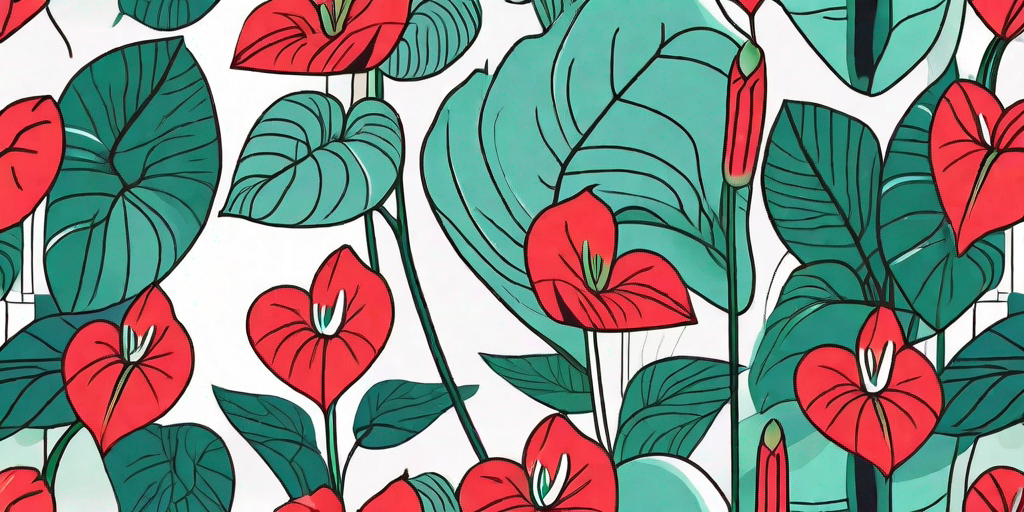
Welcome, green-thumbed enthusiasts and horticultural heroes! Today, we're delving into the enchanting world of Anthurium seeds. These little wonders, often overlooked in favor of their flashier flower counterparts, hold the key to a garden filled with vibrant, heart-shaped blooms. So, grab your trowels and let's get sowing!
Understanding the Anthurium Plant
Before we dive into the nitty-gritty of Anthurium seeds, let's take a moment to appreciate the plant they birth. Anthuriums, also known as Flamingo Flowers or Tailflowers, are native to the tropical rainforests of Central and South America. With their glossy leaves and bright, heart-shaped flowers, they're a real showstopper in any garden or indoor plant collection.
But don't be fooled by their exotic origins. Anthuriums are surprisingly easy to grow, even for those of us who struggle to keep a cactus alive. They're resilient, adaptable, and with a little love and attention, they'll reward you with a year-round display of stunning blooms.
The Anatomy of an Anthurium
What makes Anthuriums unique is their peculiar flower structure. What appears to be a single, colorful bloom is actually a spathe (a type of leaf) that surrounds a spadix (a spike covered in tiny flowers). This unusual arrangement is part of the plant's charm and adds a touch of the exotic to your home or garden.
The seeds of the Anthurium are found within the berries that grow along the spadix after the flowers have been pollinated. Each berry can contain up to six seeds, making Anthuriums a generous plant for those looking to propagate their collection.
Propagating Anthuriums from Seeds
Now that we've covered the basics, it's time to roll up our sleeves and get our hands dirty. Propagating Anthuriums from seeds is a rewarding process that requires patience, but the results are well worth the wait.
Before we begin, it's important to note that Anthurium seeds are not like your average garden-variety seeds. They're delicate, prone to drying out, and need to be sown as soon as they're harvested. But don't worry, we'll guide you through the process, step by step.
Harvesting Anthurium Seeds
The first step in propagating Anthuriums from seeds is to harvest the seeds. This is done by collecting the ripe berries from the spadix of an Anthurium plant. The berries are ripe when they are bright red and easy to remove from the spadix.
Once you've collected the berries, you'll need to extract the seeds. This can be a messy process, but think of it as a fun, hands-on science experiment. Simply squeeze the berries over a container to release the seeds, then rinse them under water to remove any remaining pulp.
Sowing Anthurium Seeds
Now that you have your seeds, it's time to sow them. Anthurium seeds need a warm, humid environment to germinate, so we recommend sowing them in a seed tray filled with a mix of peat moss and perlite. Cover the seeds lightly with the mix, then place the tray in a warm, bright location, but out of direct sunlight.
Keep the soil moist but not waterlogged, and with a bit of luck, you should start to see seedlings emerging after about six weeks. Once the seedlings have developed their first set of true leaves, they can be transplanted into individual pots.
Common Questions About Anthurium Seeds
As with any gardening endeavor, growing Anthuriums from seeds comes with its own set of questions. Here are some of the most common queries we encounter:
Why aren't my Anthurium seeds germinating?
Anthurium seeds can be finicky and require specific conditions to germinate. They need warmth, humidity, and bright, indirect light. If your seeds aren't sprouting, check that they're getting the right conditions. Also, remember that patience is key. Anthurium seeds can take up to six weeks to germinate.
Can I grow Anthuriums indoors?
Absolutely! Anthuriums make excellent houseplants. They thrive in bright, indirect light and can tolerate the dry air of heated homes. Just remember to keep their soil moist and provide them with a dose of liquid fertilizer every few weeks.
Conclusion
So there you have it, a comprehensive guide to unleashing the magic of Anthurium seeds. With a little patience, a dash of care, and a sprinkle of luck, you'll be well on your way to growing your own tropical paradise.
Remember, gardening is a journey, not a destination. So enjoy the process, learn from your mistakes, and don't be afraid to get your hands dirty. Happy planting!















